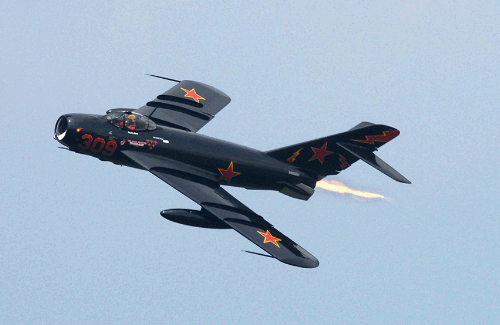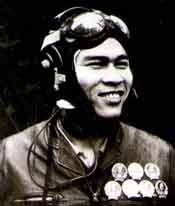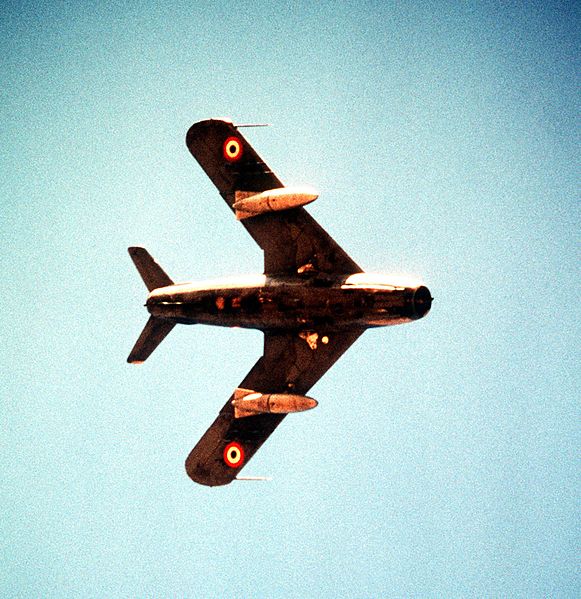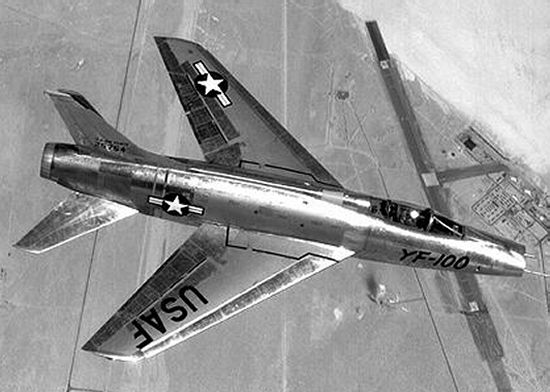History of MiG Aircraft (Part 4) – MiG-17 /MiG-19, Race towards supersonic speed
The MiG-15 was Mikoyan’s true entry to the fighter jet race. It now had to compete with the very best in the west’s arsenal. The world was racing towards developing jets that could fly higher and faster. The Soviet Union had to catch up fast so as not to lag behind again like WWII. Not only was issue about catching up, it was also about being superior. It was up to the design bureaus to design and produce aircraft that would gain the Soviet Union the superiority it desires.
In 1949, Mikoyan-Gurevich OKB began working on a replacement for the MiG-15bis. The replacement was intended to fix all problems found on the MiG-15 during combat. The result was the MiG-17. Though the MiG-17 still strongly resembled its forebear, it had an entirely new thinner and more highly swept wing and tailplane for speeds approaching Mach 1. While the F-86 introduced the "all-flying" tailplane which helped controllability near the speed of sound, this would not be adopted on MiGs until the fully supersonic MiG-19. The wing had a "sickle sweep" compound shape with a 45° angle like the U.S. F-100 Super Sabre near the fuselage (and tailplane), and a 42° angle for the outboard part of the wings. The stiffer wing resisted the tendency to bend its wingtips and lose aerodynamic symmetry unexpectedly at high speeds and wing loads.
 MiG-15 (top) and MiG-17 (bottom) comparison
MiG-15 (top) and MiG-17 (bottom) comparison
Other easily visible differences to its predecessor were the three wing-fences on each wing, instead of the MiG-15's two, the addition of a ventral fin and a longer and less tapered rear fuselage that added about 3 feet in length. The MiG-17 shared the same Klimov VK-1 engine and much of the rest of its construction such as the forward fuselage, landing gear and gun installation was carried over. The first prototype, designated I-330 "SI" by the construction bureau, was flown on the 14 January 1950, piloted by Ivan Ivashchenko. On 17 March, one of the MiG-17’s test flights ended up in disaster when the aircraft developed flutter which tore off his horizontal tail, causing a spin and crash. Pilot Ivan Ivashchenko was killed in the crash.
On 1 September 1951, the aircraft was accepted for production, and formally given its own MiG-17 designation after so many changes from the original MiG-15. It was estimated that with the same engine as the MiG-15's, the MiG-17's maximum speed is higher by 40–50 km/h, and the fighter has greater maneuverability at high altitude.
Serial production started in August 1951, but large quantity production was delayed in favor of producing more MiG-15s so it was never introduced in the Korean War. It did not enter service until October 1952, when the MiG-19 was almost ready to be flight tested. During production, the aircraft was improved and modified several times. The basic MiG-17 was a general-purpose day fighter, armed with three cannons, one Nudelman N-37 37mm cannon and two 23mm with 80 rounds per gun, 160 rounds total. It could also act as a fighter-bomber, but its bomb load was considered light relative to other aircraft of the time, and it usually carried additional fuel tanks instead of bombs.
Although a canopy which provided clear vision to the rear necessary for dogfighting like the F-86 was designed, production MiG-17Fs got a cheaper rear-view periscope which would still appear on Soviet fighters as late as the MiG-23. By 1953, pilots got safer ejection seats with protective face curtain and leg restraints like the Martin-Baker seats in the west. The MiG-15 had suffered for its lack of a radar gun-sight, but in 1951, Soviet engineers obtained a captured F-86 Sabre from Korea and they copied the optical gun-sight and SRD-3 gun ranging radar to produce the ASP-4N gun-sight and SRC-3 radar. The combination would prove deadly over the skies of Vietnam against aircraft such as the F-4 Phantom whose pilots lamented that guns and radar gun-sights had been omitted as obsolescent.
The second prototype variant, "SP-2" (dubbed "Fresco A" by NATO), was an interceptor equipped with a radar. Soon a number of MiG-17P ("Fresco B") all-weather fighters were produced with the Izumrud radar and front air intake modifications.
In early 1953 the MiG-17F day fighter entered production. The "F" indicated it was fitted with the VK-1F engine with an afterburner by modifying the rear fuselage with a new convergent-divergent nozzle and fuel system. The afterburner doubled the rate of climb and greatly improved vertical maneuvers. But while the plane was not designed to be supersonic, skilled pilots could just dash to supersonic speed in a shallow dive, although the aircraft would often pitch up just short of Mach 1. This became the most popular variant of the MiG-17. The next mass-produced variant, MiG-17PF ("Fresco D") incorporated a more powerful Izumrud RP-2 radar, though they were still dependent on Ground Control Interception to find and be directed to targets. In 1956 a small series (47 aircraft) was converted to the MiG-17PM standard (also known as PFU) with four first-generation Kaliningrad K-5 (NATO reporting name AA-1 'Alkali') air-to-air missiles. A small series of MiG-17R reconnaissance aircraft were built with VK-1F engine (after first being tested with the VK-5F engine).
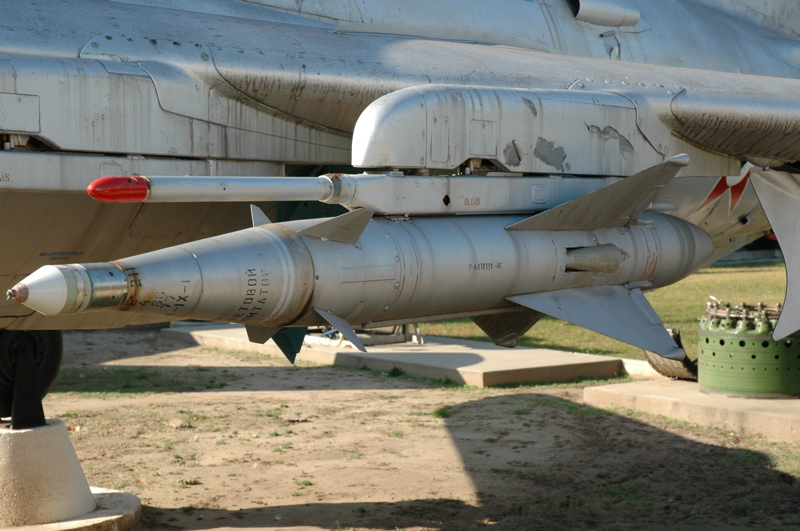 AA-1 Alkali Air-to-air missile
AA-1 Alkali Air-to-air missile
Over 6,000 MiG-17s were built in the USSR by 1958. Another 2,000 were built under license in Poland and China.
The MiG-17 is remembered for its participation in the Vietnam War and Arab-Israeli War. The MiG-17 was the primary interceptor of the fledgling Vietnam People's Air Force in 1965, scoring its first aerial victories and seeing extensive combat during the Vietnam War, the aircraft frequently worked in conjunction with MiG-21s and MiG-19s. Many historians believe that some North Vietnamese pilots, in fact, preferred the MiG-17 over the MiG-21 because it was more agile, though not as fast; however, of the 16 NVAF Aces of the war, 13 of them attained that status while flying the MiG-21. Only three North Vietnamese Airmen gained Ace status while flying the MiG-17. Those were: Nguyen Van Bay (7 victories), Luu Huy Chao and Le Hai (both with six).
MiG-17s saw action in nearly all of the Arab-Israeli conflicts starting when 12 of them served with the Egyptian Air Force during the Suez Crisis of 1956, plus hundreds more served, and were mostly destroyed, in the Egyptian and Syrian Air Forces during the Six-Day War of 1967 as well as the War of Attrition, the 1973 Yom Kippur War, and the 1982 Israeli Invasion of Lebanon.
On 20 April 1951, OKB-155 was given the order to develop the MiG-17 into a new fighter called "I-340", which was to be powered by two Mikulin AM-5 non-afterburning jet engines (a scaled-down version of the Mikulin AM-3) with 19.6 kN (4,410 lbf) of thrust. The I-340 was supposed to attain 1,160 km/h (725 mph, Mach 0.97) at 2,000 m (6,562 ft), 1,080 km/h (675 mph, Mach 1.0) at 10,000 m (32,808 ft), climb to 10,000 m (32,808 ft) in 2.9 minutes, and have a service ceiling of no less than 17,500 m (57,415 ft). The new fighter, internally designated "SM-1", was designed around the "SI-02" airframe (a MiG-17 prototype) modified to accept two engines in a side-by-side arrangement and was completed in March 1952.
The prototype suffered from poor cockpit pressurization and the engines proved temperamental with frequent flameouts and surges with rapid throttle movements. The engines were upgraded to the AM-5A standard with 21.1 kN (4,740 lbf) of thrust each, which exceeded the power output of the Klimov VK-1F in afterburner while providing better fuel economy. The SM-1 was barely supersonic, reaching 1,193 km/h (745 mph) at 5,000 m (16,404 ft)—Mach 1.03. This performance was deemed insufficient for the new supersonic fighter and an afterburning version of the engine, the AM-5F, was proposed. While not implemented, the AM-5F served as the basis for the Tumansky RD-9 which powered production aircraft. Further development of the twin-engine concept resulted in a government request for the "I-360", internally designated "SM-2", which was also powered by the AM-5F engines, but featured a highly swept wing.
SM-2 (I-360) was built in 1952 and, compared to SM-1, had 1.6m longer fuselage, wingspan reduced from 9.26 to 9.04m, and weight increased from 5219 to 6802 kg. SM-2 also had a new 55° wing. N-37D guns were placed in wing roots to open space in a nose for the radar. Cockpit and landing gear were redesigned, and low vertical stabilizer increased in size. In April 1952 first prototype was sent to LII, with first flight on May 27, 1952 by G. A. Sedov. It was immediately clear that AM-5A engines were not powerful enough, and they were replaced with AM-5F [2150 kg/2700 kg with afterburners]. New engines allowed for M=1.19 in horizontal flight. As a result of testing air brakes and control surfaces were slightly modified, with new aircraft receiving designation SM-2A, and then [after additional modifications] SM-2B.
Second prototype, SM-2/2 had modified tail [low-positioned horizontal stabilizers instead of T-tale], and guns with shorter barrels. However, AM-5F was still not considered powerful enough, and both prototypes received yet more powerful AM-9B [2600 kg/3250 kg with afterburners]. Serialized version of that engine was designated RD-9B. With the new engine, SM-2B received designation SM-9/1, first flight on January 5, 1954, by G. A. Sedov, who made a total of 132 flights. Final changes included modified air intake, new NP-23 guns [340rounds], radio RSIU-3M "Klen", responder "Uzel-1", and radio-rangefinder SRDM-1M "Konus"
The Soviet of The Ministers of the Soviet Union issued an order #286-133 to start serial production on February 17, 1954 [factories in Gorkiy and Novosibirsk]. Factory trials were completed on September 12, 1954, and government trials started on September 30.
Initial enthusiasm for the aircraft was dampened by several problems. The most alarming of these was the danger of a midair explosion due to overheating of the fuselage fuel tanks located between the engines. Deployment of airbrakes at high speeds caused a high-g pitch-up. Elevators lacked authority at supersonic speeds. The high landing speed of 230 km/h (145 mph) (compared to 160 km/h (100 mph) in the MiG-15), combined with absence of a two-seat trainer version, slowed pilot transition to the type. Handling problems were addressed with the second prototype, "SM-9/2", which added a third ventral airbrake and introduced all-moving tailplanes with a damper to prevent pilot-induced oscillations at subsonic speeds. It flew on 16 September 1954, and entered production as the MiG-19S.
Approximately 5,500 MiG-19s were produced, first in the USSR and in Czechoslovakia as the Avia S-105, but mainly in the People's Republic of China as the Shenyang J-6. The aircraft saw service with a number of other national air forces, including those of Cuba, North Vietnam, Egypt, Pakistan, and North Korea. The aircraft saw combat during the Vietnam War, the 1967 Six Day War, and the 1971 Bangladesh War.
The MiG-19 will forever be remembered as the world’s first operational supersonic jet fighter. It appeared a year before the American YF-100 prototype (first prototype flights for the two aircraft were May 25, 1953 and May 27, 1952, respectively).
The MiG-17 is another “must see” fighter in a lot of Egyptian military museums. Below are pictures of the fighter in the 6thof October War Panorama and Citadel Military Museum. Although the MiG-19 served with the Egyptian Air Force during the 6 Day war, it is not displayed in any Egyptian military museum. The reason behind this could be the fact that Egypt lost so many of it during the 6 day war and replaced it with the latest MiG-21 fighters. So there isn’t really much left to display in museums. I included pictures of MiG-19s during their service in the EAF below the EAF MiG-17s.
As for modeling, I own a DeAgostini 1:112 die cast model of the MiG-19 and a 1:100 model of the MiG-17. I posted some pictures of the two models below.
The MiG-19 was but a stepping stone towards reaching speeds of up to Mach 2. On the same year it was introduced, its successor the MiG-21 made its first flight as the Ye-2 prototype. This aircraft would become the most produced supersonic jet aircraft in history and would serve in 50 countries around the world (with some still in service until our present day). The story of the MiG-21 will be discussed in Part 5 of this series.
To be continued..
Tags:
Replies to This Discussion
-
Permalink Reply by JEAN-FRANCOIS QUILLIEN on November 15, 2012 at 2:06am
-
This could be a book publication! Encyclopedic work ! Bravo, Ahmed!
-
Permalink Reply by Johmar Llonor on November 15, 2012 at 2:49am
-
What a piece of aviation history. MiG was one of the greatest design beureu ever existed.
Recent Visitors to the site!
© 2025 Created by Matt Whisenant.
Powered by
![]()

